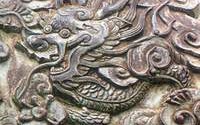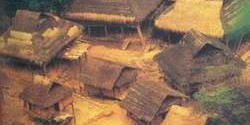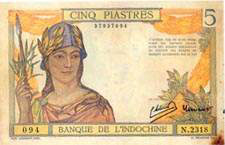 New coins were minted by every new dynasty in the East. But kings were not the only ones to issue their own money…
New coins were minted by every new dynasty in the East. But kings were not the only ones to issue their own money…
For the four short days of the year 1521 in which his contemporaries called him “King,” Tran Cao did one major thing to commit his name to posterity: he minted his own coins.
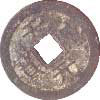 Issuing coins with the name and year of the new dynasty was a priority for newcomers to the throne. It immediately invalidated the old regime, at the same time as popularizing and authorizing the new ruler. Even if there weren’t enough raw materials to widely issue the coins, they were still struck, vital symbols of the new era.
Issuing coins with the name and year of the new dynasty was a priority for newcomers to the throne. It immediately invalidated the old regime, at the same time as popularizing and authorizing the new ruler. Even if there weren’t enough raw materials to widely issue the coins, they were still struck, vital symbols of the new era.
Dynastic coins were given names which in translation are strongly reminiscent of the electioneering slogans a modern day politician might “coin.” The oldest money in Vietnam is the “Thai Binh Hung Bao,” or “Peace and Prosperity Guaranteed” coin, made in 968 AD for the Dinh dynasty. In the 16th century; Mac Danh Dzung minted the “Dai Chinh Thong Bao”- “A Strong and Stable System” -coins out of iron.
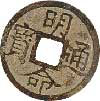 Most coins were made of copper, tin or zinc. They were about three centimeters round, with a square hole in the centre. This basic design, symbolic of Sun and Earth according to Oriental concepts -not to mention being handy for tying with string -still appears in Japan’s five yen coin.
Most coins were made of copper, tin or zinc. They were about three centimeters round, with a square hole in the centre. This basic design, symbolic of Sun and Earth according to Oriental concepts -not to mention being handy for tying with string -still appears in Japan’s five yen coin.
After the Dinh dynasty introduced them, the Le, Ly, and Tran dynasties all issued similar coins throughout their kingdoms, with their own designs. The Phi Long coins bear flying dragons, a symbol of royalty. Tam Da coins refer to the three old men, Phuc, Loc and Tho, who represent Luck, Health and Wealth, while the Ngu Phuc coins show five lucky symbols: Phuc, Loc, Tho, Hang (peacefulness) and Ninh (fertility). These lucky qualities are incorporated into a design of five bats on the reverse.
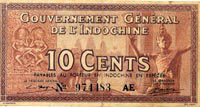
In the 14th century, the Ho dynasty printed Vietnam’s first paper money. Or leaf money, is probably more accurate. Researchers believe cut leaves were printed with designs such as seaweed, waves, clouds, and turtles, using a simple lithographic process. The material was passed through two carved stone rollers, which were inked with vegetable dyes.
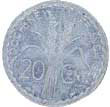 A press from these times has survived, but none of the notes, and after the Ho dynasty, money went back to being made from metal. Medals, for bravery and loyal service, were also struck by these regimes. Like coins of currency, they featured the year name on the front, and animals -up to eight of them -on the back. One shows a galloping horse and the phrase “Long March of a Thousand Miles;” this was like Vietnam’s first steeple-chasing prize, being awarded to the owners of horses which distinguished themselves in battle.
A press from these times has survived, but none of the notes, and after the Ho dynasty, money went back to being made from metal. Medals, for bravery and loyal service, were also struck by these regimes. Like coins of currency, they featured the year name on the front, and animals -up to eight of them -on the back. One shows a galloping horse and the phrase “Long March of a Thousand Miles;” this was like Vietnam’s first steeple-chasing prize, being awarded to the owners of horses which distinguished themselves in battle.
Also common were amulet coins, used by fortune tellers and medicine men. Many of these had four characters on the face: “Thai Thuong Lao Quan”, the name of the founder of Taoism. On the reverse were depictions of certain gods or spirits; many have mysterious inscriptions whose meanings are unknown even now.
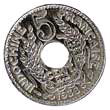 The most famous of old Vietnamese coins features a couple making love, reflecting an Asian philosophy that the proserity of the nation and its continuity are the cornerstones of man’s existence. The same concept is conveyed in other Vietnamese antiques such as bronze drums of Ngoc Lu, Dong Son and other areas.
The most famous of old Vietnamese coins features a couple making love, reflecting an Asian philosophy that the proserity of the nation and its continuity are the cornerstones of man’s existence. The same concept is conveyed in other Vietnamese antiques such as bronze drums of Ngoc Lu, Dong Son and other areas.
The feudal system was replaced by the rule of the French when they invaded Vietnam in 1858. With Cambodia and Laos also under their control, in 1875 they set up the Bank of Indochina, and ten years later issued the first Indochinese notes and coins. The banknotes were valid in all three countries (although they did not reach northern Vietnam until 1899), in denominations of five and 20 dong, with a one dong note introduced in 1892.
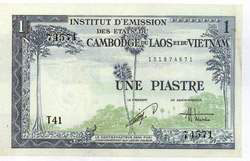
The value of the Indochinese currency unit was fixed at 0.655g of gold when first issued; the US dollar at the time was worth 0.8867g. Old people still reminisce about the days when one trinh -one thousandth of a dong -bought breakfast; and two xu -one hundredth of a dong -was enough for a bowl of noodles. The dong was tied to the value of the franc, at one-tenth, so as the franc devalued, the dong did too. A 500 dong note was issued in 1944.
Initially, the Bank of Indochina printed its paper money in France. From 1940, however, 100, 50, 20 and one dong notes were printed at the Vien Dong IDEO and Taupin printing houses in Hanoi (now Yen Phu Gate and the Cua Narn general store, respectively).
This early attempt at monetary union ended in 1954, with the battle of Dien Bien Phu. Before that, on the 31st of January 1946, President Ho Chi Minh signed into existence Vietnam’s “revolutionary currency.” Called “Finance money,” because the State Bank hadn’t been established yet and the notes were issued by the Ministry of Finance, the notes were popularly known as “Uncle Ho’s money”. All the notes had the new president’s picture on them.
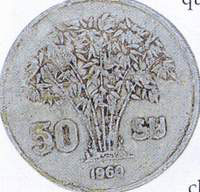 The 100 dong note had a buffalo on one side, recalls the designer of Uncle Ho’s money, Nguyen Huyen, which represented agriculture; while on the other side were a farmer with a hoe, symbolizing production, and a bricklayer, who stood for construction. “The note was in three colours,” said Huyen, “blue, yellow and brown, with the buffalo in blue, for the sake of harmony. But also because it was the easiest ink to find.”
The 100 dong note had a buffalo on one side, recalls the designer of Uncle Ho’s money, Nguyen Huyen, which represented agriculture; while on the other side were a farmer with a hoe, symbolizing production, and a bricklayer, who stood for construction. “The note was in three colours,” said Huyen, “blue, yellow and brown, with the buffalo in blue, for the sake of harmony. But also because it was the easiest ink to find.”
This note was printed until 1951, by which time the printing house had moved twice as war with the French escalated, and the National Bank of Vietnam had finally been established. New notes in higher values were issued in 1958; these were in use until the end of 1978.
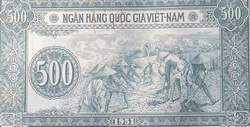
In the South, from 1948 to 1978, money was replaced several times. Early on, each region had its own currency; notes for example would have “For circulation in Long Chau Sa province only” stamped on them. In 1955, all of these varieties of money were void upon the summons of troops to the north. From then until the liberation of the South in 1975, all southern provinces used money issued by the Saigon government.
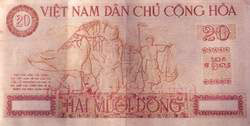
“Liberation” notes were used until 1978, when the national monetary system was finally unified. Since then, a new series has been issued once, in 1985. Today’s 20,000 and 50,000 dong notes were added in 1994 and 1995.
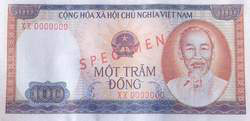
The best set of notes in terms of printing quality and design is the 1958 series. One of designers, artist Bui Trang Chuoc, says in his biography that he finished the designs for the money in one week in 1956, then went abroad for a year before returning to prepare for printing. The identity of the artist was only revealed in February 1959, as a security measure.
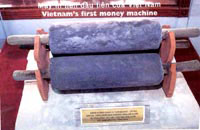
With all these changes, it is easy to see why people are reluctant to convert gold into cash. But paper money still has an important symbolic function in Vietnam, besides its more practical uses. Fake notes are placed on altars and burnt at funerals, and every Tet, children are given a fresh new bank note, or more, by their parents. This expresses the hope that their offspring will grow up rich, clever, and faithful.
 Vietnamese Culture and Tradition
Vietnamese Culture and Tradition 
